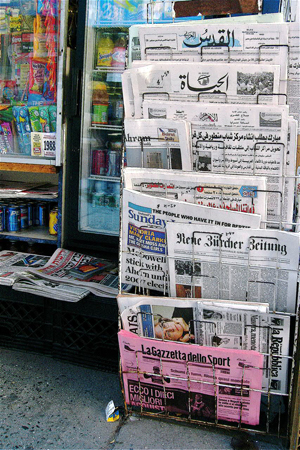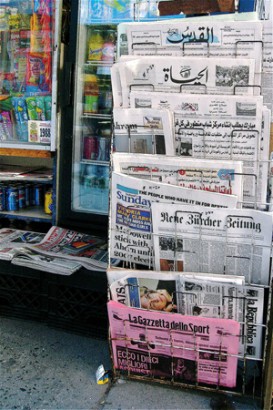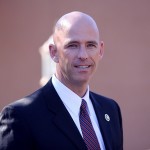It was one prickly “bull session.” Nothing personal. Ethnic and community journalists demanding to know why ads weren’t coming to their newspapers and advertising executives trying to reason with the crowd, claiming they don’t have big budgets and need to carefully pick and choose their ad placements.
At a no-holds-barred forum in January, “Outlook for Advertising for Community and Ethnic Media,” organized by the CUNY Graduate School of Journalism, journalists, bloggers and publishers from New York laid out the importance of their survival and argued that advertisers were ignoring an important segment of the city’s population.
Ethnic and community publications have always found it difficult to compete with mainstream media when it comes to attracting advertising dollars, and the new digital journalism environment has only made it harder. Even as some ethnic media outlets have expanded their online presence to reach more readers and keep costs down, they have found that their investments in technology are not getting the expected returns in terms of advertising.
There was some blame-throwing around the room. The ad executives said publications should be more creative and up to date with technology; ethnic press publishers countered that advertisers should remove their blinders and appreciate the intimate relationship community papers have with their readers.
While the advertisers said they recognized the “trust factor” of the ethnic press, high circulation numbers and visibility were key to making ads worth their while.
For a city where foreign-born residents make up nearly 40 per cent of the population, one might think that municipal government and businesses would consider it a no-brainer to advertise in the ethnic press. But that doesn’t seem to be the case, partly because those media outlets don’t provide proof of their readership numbers.
Advertisers typically depend on a newspaper’s audit, a bi-annual process where circulation is independently verified. It is a costly procedure, and many community papers with low circulation and a paltry budget don’t bother with it. The audit allows advertisers to see the “numbers you say you have,” said Iris Robertson, media supervisor at UniWorld Group multicultural marketing company.
“Get the audit,” Teresa Cabrero, managing director of Diario de Mexico USA, urged colleagues in the ethnic media. She claimed her newspaper has benefited from a steady stream of advertising because of its audit. “Problem is, very few papers have good audit.”
Many journalists at the forum grumbled that advertisers should start thinking outside the box. Instead of audits, shouldn’t they be evaluating a publication’s reach via social media tools like Facebook and Twitter, instead?
Statements made by Chris Coffey of the Mayor’s Office of Media and Entertainment rubbed salt into the festering wound of ad marginalization. He revealed that 93 percent of City Hall’s advertising goes to mainstream media, such as The New York Times, the Daily News, the Staten Island Advance and The Wall Street Journal.
That number has shifted to about 75 percent in the past few years, Coffey quickly added, as ad buying for anti-smoking campaigns and NYPD recruitment, for instance, began to “diversify.” He urged journalists to contact the two agencies that buy ads for New York City government.
Some advertisers and public relations representatives at the forum said they want to work with the ethnic press, but didn’t know how. Director of communications for Health Plus Kathryn Soman said the HMO would love to work with ethnic media, because they have products geared specifically for immigrant communities. But she said she found that the chain of command in ethnic media is sometimes nebulous, and “it is harder to find a person you need to talk to.”
For people in the business of communication, there seemed to be a communication divide.
Part of the problem may be that it’s difficult to keep up with the city’s changing demographics. A Bengali editor asked Maria Cristina Rios, Macy’s director of multicultural marketing and media strategy, why Macy’s places congratulatory ads for Christian and Jewish holidays, but not the Muslim holiday Eid-al-Fitr marking the end of Ramadan. Muslim immigrants are among the store’s loyal customers, he said.
Rios premised her response by saying the department store chain advertises in minority papers. But running congratulatory ads for certain holidays, she added, would “require research.”
While the forum gave everyone a better understanding of the barriers and how to overcome them, the protagonists did not come to any tangible agreement on how to move forward as partners.
Privately, people were taking note. “Too expensive to keep up with technology…but, we’ll see,” said a Filipino newspaper editor. An Indian editor hinted that if “too much money is involved, never mind.”
There could be some change ahead. Coffey said some city agencies are exploring the benefits of placing ads in languages other than English. But the pace is not as fast as the ethnic and community journalists, racing to survive, would hope it to be.
Feet in Two Worlds is supported by the New York Community Trust and the John S. and James L. Knight Foundation with additional support from the Mertz Gilmore Foundation and the Sirus Fund.





